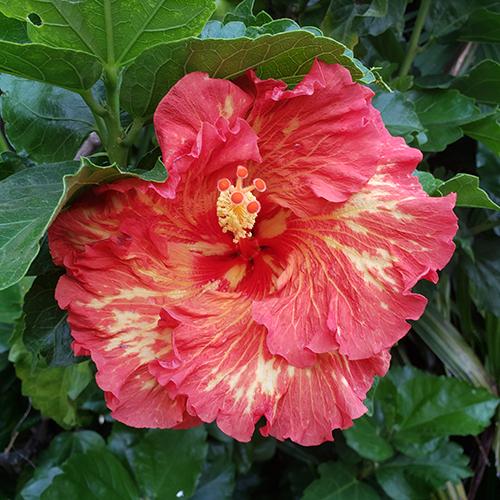
Benefits of Hibiscus
Hibiscus helped save our puppy We found a pedigree Golden retriever for sale for $50 in the local paper. At the time, they were selling

Growing up in Michigan in the 50s, we would summer at a tent and trailer park on the bank of Lake Huron. Many hours were spent playing and running around outside, swimming and fishing in the lake and hanging out on the beach.
In those days people were more interested in getting a tan than protecting their skin from sun damage. By this time in our history a tanned person was considered more attractive than a pale person. In times past tanned skin was the mark of a field or construction worker. Later, as more folks moved indoors to do their work, a tan was more the sign of the leisure class who could spend more time on the gulf course, fishing or generally recreating outside.
As gingers we paid dearly for our time in the sun, routinely getting sunburned and having contests seeing who could peel off the biggest pieces of dead skin. I later found that applying mashed up papaya was useful. Papain, the enzyme found in papaya is attributed with soothing skin irritations and its anti-inflammatory properties making it an ideal ingredient for acne and blemish-prone skin. Its natural and effective exfoliating properties brighten the skin by removing dead skin cells and flaky patches on the top layer of the skin.
At some point folks realized that suntan and sunburn were actually signs of sun damage and embraced the practice of applying sunscreen with sun protective factor (SPF) to prevent getting burned by the ultraviolet radiation.
Those lazy hazy days of Summer are typically vacation time for a multitude of folks. This is also the time we most need to pay attention to the sun and the potential risk it can pose to our eyes and skin.
Just as hair styles and skirt lengths have gone thru many changes over the years, so has the appearance of our skin. Before the industrial revolution, a mark of the leisure class was fair skin. Having a tan was a sign of outside labor.
When populations shifted from agricultural work to factory work, often with long hours, the symbol of leisure became tanned skin.
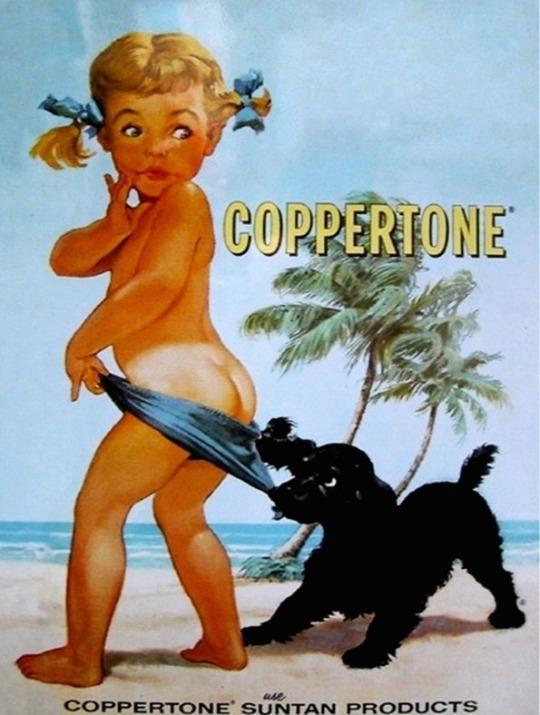
The 1950s saw the creation Little Miss Coppertone, who appeared in their ads with her puppy. Sun products during this era were formulated to maximize a tan and weren’t protective.
Tanning became common in the 1960s, popularized by French actresses such as Brigitte Bardot. A tan meant you could afford to hang out on the French Riviera.
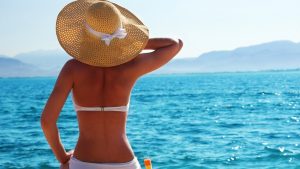
Ultraviolet is the band of sun rays that fall in the middle of the magnetic spectrum and include UVA, UVB and UVC.
Humans are increasingly exposed to UV radiation as the ozone is depleted and/or global warming intensifies reflection.
People of all colors should be aware of the need to protect themselves from exposure as it has become evident that exposure to UVB and UVA is potentially lethal to humans.
During the past two decades it has become increasingly evident that exposure to ultraviolet radiation, UVB and UVA, is potentially lethal to humans. When these sunrays hit the skin, some are scattered, some reflected but much is absorbed by chromosomes and cell proteins. This absorption causes damage to the cell’s deoxyribonucleic acid (DNA) which in turn triggers a response that can lead to cancer, eye damage or blindness.
Sunburn can occur in less than 20 minutes in the summer. Tanning, which is also considered evidence of skin damage, is a delayed reaction. Tanning salons, in an effort to avoid burning, began using mainly UVA lamps in sun beds. Unfortunately, this use of UVA may cause even more serious long-term damage as UVA penetrates the layers of skin more deeply than UVB.
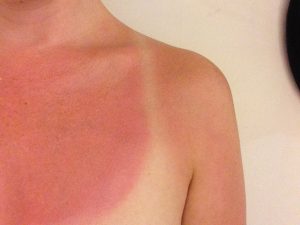
In May 2000, the National Institutes of Health added ultraviolet radiation and exposure to sun lamps and tanning beds to the list of identified carcinogens.
In 2002, they went further, stating that each component, UVA, UVB and UVC was reasonably anticipated to be human a carcinogen.
Sunburn is attributed to UVB and can occur in less than 20 minutes in the summer. Sun screens are rated in SPF (Sun Protective Factor) which is only rating its ability to block UVB.
The problem with them is that by reducing the risk of getting a sunburn, folks are enabled to stay in the sun for longer periods of time.
Unfortunately, this means more exposure to UVA which may cause even more serious long-term damage, as UVA penetrates the layers of skin more deeply than UVB and causes more skin damage.

With the alarming numbers of skin cancers being diagnosed around the world, it is increasingly evident that people of all colors need protection from ultraviolet radiation.
Protection should begin as soon as a baby is born and continue throughout life. This is particularly important for people who have fair skin and light eyes. Babies should be kept out of direct sunlight and should wear sun protective clothing, including hats and sunglasses.
While most sunscreen can be used on infants, it is better to only use a sunblock with zinc and/or titanium dioxide. Apply the sunblock only on exposed skin and only when exposure is unavoidable.
There are many easy-to-use products that can help make our lives sun safer.
Sun protective clothing, including hats, sunglasses, sun screens, umbrellas, sun shades, awnings, canopies, window film or UV film will help provide protection from ultraviolet radiation.
When choosing a sun screen, be aware that many brands are full of bad chemicals. And I mean really bad… such as a commonly incorporated ingredient, oxybenzone.

Oxybenzone — also called benzophenone-3 and sometimes Milestab 9, Eusolex 4360, Escalol 567, or KAHSCREEN BZ-3 — is a chemical compound that is the active ingredient in most over-the-counter sunscreens and other personal care and skincare products.
Endocrine-disrupting chemicals such as oxybenzone may mimic hormones, cause endometriosis and can pose a risk to reproductive systems.
Oxybenzone has been increasingly linked to early puberty in girls, low sperm count and male infertility, and an increase in hormone-related cancers in men and women.
The directions for such products warn us of the need to reapply them often. What they don’t tell us is that if we don’t, UV breaks them down and produce byproducts that cause cancer!
Full-spectrum sunscreens claiming to be “natural” may contain avobenzone (Parsol 1789). Although considered safe, disintegration products may have significant health impacts and persist in the environment.
A recent study at Lomonosov Moscow State University found that chlorinated water and ultraviolet light can cause avobenzone to disintegrate into various other organic compounds, including; aromatic acids, aldehydes, phenols, and acetophenones which may have adverse health effects.
Probably not a good one to use around the pool.
Whatever combination of strategies you choose to employ, consideration needs to be given to choosing full-spectrum protection which means blocking both UVA and UVB. So, not just sunscreens but sunblocks.
Sunscreens are best if they are broad-spectrum and have an SPF 30+.
You should also know that all sunscreens should be applied 20 minutes before being exposed to the sun and should be reapplied every two hours while exposed.
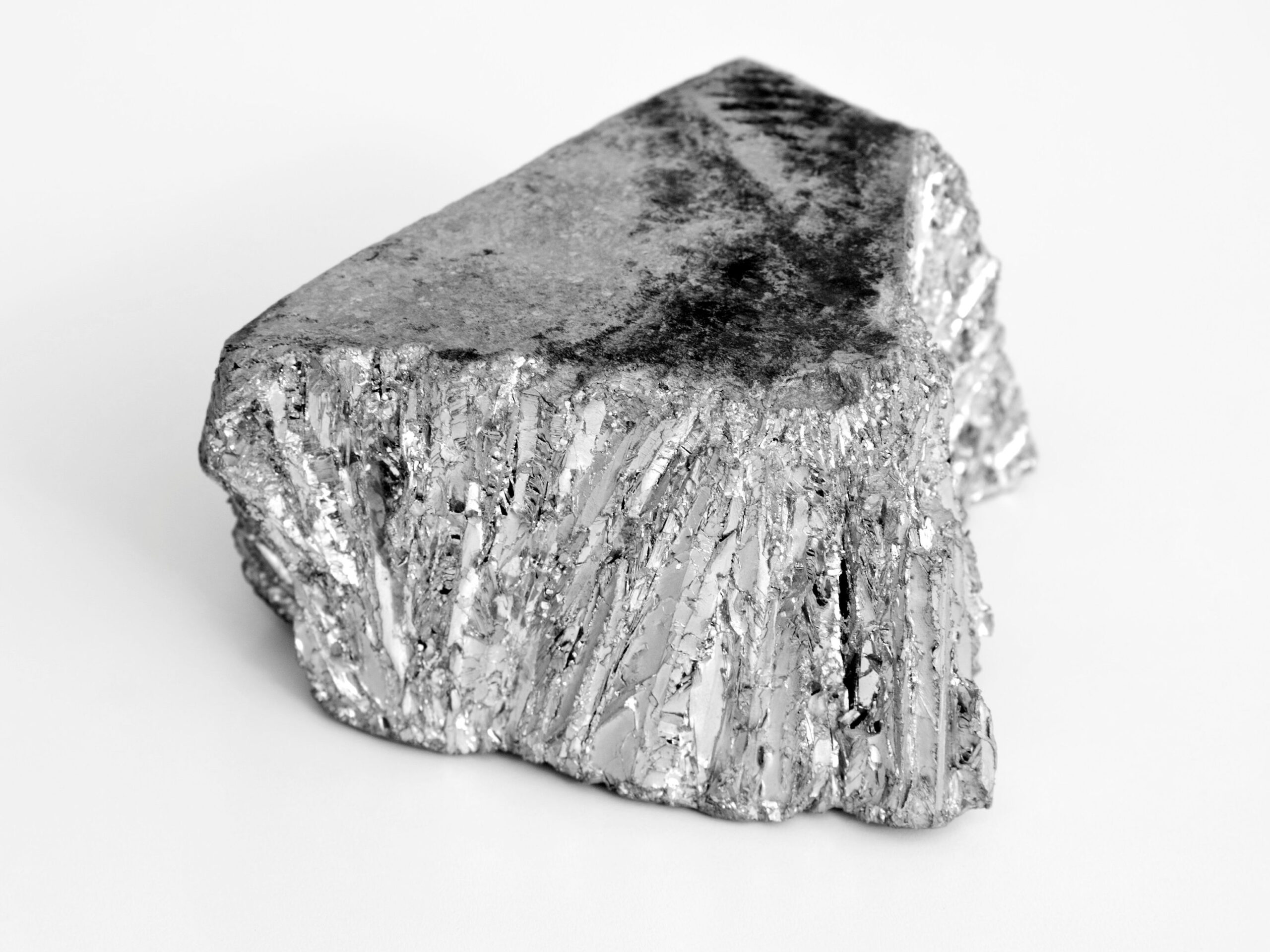
Zinc plays a role as a component of many enzymes and as a catalyst of enzyme systems regulating cell growth, DNA and protein synthesis, energy metabolism, regulation of gene transcription, hormone levels and growth metabolism.
It’s necessary for anyone who wants healthy skin, bones, hair, nails and eyes and is essential in hormone production.
Zinc supplements are used to support normal growth and health and to alleviate zinc deficiency (a condition referred to as hypozincemia.) Lack of zinc may result in poor vision at night, slow healing of wounds, a decrease in sense of taste and smell, a reduced ability to fight infections and poor development of reproductive organs.
In children lack of zinc causes growth retardation, delayed sexual maturation, infection susceptibility and diarrhea, contributing to the death of about 800,000 children worldwide per year. In men deficiency is responsible for inflammation of the prostate which can lead to cancer of that organ.
Zinc deficiency is a worldwide risk and has been attributed to be the fifth leading risk factor for disease in the developing world. Up to 73% of the population is at risk in certain countries. Overall, even conservative estimates suggest that 25% of the world’s population is at risk of zinc deficiency. Pumpkin seeds are a good source of Zinc but I take a supplement daily
Zinc oxide is a chemical compound consisting of one zinc atom bound to one oxygen atom. As a dietary supplement, it is used to supply the body with zinc, an essential mineral.
It is opaque and reflects and scatters light, explaining why it is useful in a sunblock. When applied topically, it offers protection such as would be provided if we were wearing a suit of armor. It also protects us from outside irritants and serves as an astringent, promoting the healing of wounds and acts as a weak antiseptic.
By 1920, zinc oxide, a physical sun blocker and the best broad-spectrum protection available, was already being used for sun protection, and reportedly had been used for centuries for this purpose.
Zinc oxide is used in many creams and ointments to prevent or alleviate sunburn and other skin irritations. It’s also available in oral formulations to promote wound healing. It is the main ingredient in Desitin, a cream to help soothe, treat and prevent diaper rash and used to treat mild itchiness as well as Calamine lotion used to treat mild itchiness from sunburn, insect bites, poison ivy, poison oak, and other mild skin conditions.
The mineral also works as an antioxidant, offering protection from free radical molecules that can damage cell membranes.
While demonstrating making a natural sun block with zinc oxide I failed to allow the mixture cool a bit before pouring the hot liquid into a silicone tube and it melted the tube, spilling the hot liquid down my bare leg, burning it quite severely. But to my surprise, due to the healing properties of the zinc, it relieved the pain and healed in a few days.
Zinc oxide is available in bulk powder form for about $15/pound. This equates to about 60 cents worth of zinc oxide in a $12 (2.9 ounce) tube of sunblock with 18.75% zinc oxide (offering a UPF of 30).
Zinc Oxide Powder does not readily dissolve in water but will suspend into a somewhat cloudy mixture when stirred. It does dissolve in oils quite well.
When working with zinc oxide powder, be careful not to inhale the powder as inhalation of large amounts could present heath risks.
At Self-Heal School we offer a workshop, Summer Herbal Home Spa, in which I demonstrate making a water proof UPF (Ultraviolet Protection Factor) sunblock with Zinc Oxide.
I make my own UPF 30 water-resistant sun block that is fairly waterproof and can be tinted to my skin color so that it virtually disappears on the skin.
Ingredients & Supplies (makes one cup)
measurements by weight
Method
Most people don’t realize that regular summer clothing lets through a surprising amount of UV. Of course, summer styles also typically expose a lot of skin to the sun.
I was surprised to find that a white cotton tee shirt has an SPF of only 5-7. Soaking it for the wet tee shirt contest lowers the SPF to only 2!
I have a few UPF 50 long sleeve shirts that are made for hiking and are vented to keep me cool, while providing maximum protection. I also have a UPF 50 wide brimmed hat.
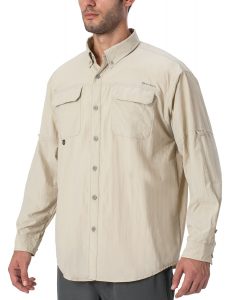
Sun protective clothing should offer at least a UPF of 30+ and therefore block 97 percent of UV.
| UPF RATING | PROTECTION CATEGORY | % UV BLOCKED |
| 15-24 | Good | 93.3-95.9 |
| 25-39 | Very Good | 96-97.4 |
| 40-50+ | Excellent | 97.5-98+ |
Living in the southern California with plenty of sunshine and plenty of heat, many times clothes are lightweight and light in color – perfect for allowing the sun’s ultraviolet rays to penetrate.
A product that helps clothing protect your skin is Rit SunGuard. It is a laundry additive that enhances the level of UV protection provided by your existing clothes.
However, the protection provided by Rit will wash out over time and it only works with cottons and other natural fabrics. Rit claims that it will last through twenty wash cycles.
It is an at-home fabric treatment that coats clothing and helps block more than 96 percent of the sun’s harmful ultraviolet rays from reaching the skin.
A treatment provides an ultraviolet protection factor (UPF) of 30 (similar to the SPF or sun protection factor rating for sunscreen).
SunGuard works by penetrating the fibers of washable clothing and coating them with a formula that blocks ultraviolet rays. Listed product ingredients are Sodium Chloride and Nonionic Surfactants.
It is safe for all washable natural fabrics including cotton, linen, rayon and silk. It will not add sun protection to polyester, acrylic or other synthetic fibers. It can be used on blended fabrics but the final protection will not be as effective.
It is recommended for use on children’s clothing after the age of six months. It can’t be used as a spray-on treatment for hats, umbrellas or outdoor fabrics.
It doesn’t change the texture or feel of the fabric. You won’t notice any difference in breathability of the fabric. It has earned the endorsement of The Skin Cancer Foundation and The Good Housekeeping Seal of Approval.
Follow instructions included with the product.
Sun damage to eyes can occur anytime during the year, not just in the summertime, so be sure to wear UV-blocking sunglasses and a broad-brimmed hat whenever outside.
Don’t be fooled by clouds: the sun’s rays can pass through haze and thin clouds.
Find out more at the American Academy of Opthalmology.
As the sun moves higher in the sky, the sun’s rays become more intense and damaging to the skin and eyes. This is because the ultraviolet (UV) light travels a shorter, more direct distance to reach the Earth.
The peak sun intensity hours, when UV light is strongest, are between 10 a.m. and 3 p.m. standard time or 11 a.m. and 4 p.m. daylight savings time. When possible, plan outdoor activities for early morning or late afternoon when the sun’s rays are less intense. By avoiding sun exposure during peak hours, sun exposure may be reduced by as much as 60%.
If outdoor activities during these peak times are unavoidable, encourage the use of protective clothing and sunglasses, play or work in shaded areas, and always use full-spectrum sunscreen.
Shade can help protect us from the sun, but not all shade is created equal. The quality of shade an object provides depends on the sun’s position in the sky, the size of the object making the shadow, and how much sunlight can penetrate the object.
And remember, if you’re at the beach, even if you are blocking direct sunlight with a hat or shade, reflected UV off the sand and water is still hitting you and can cause burning and other sun damage.

Exercise common sense when planning time outdoors. We can get our Vitamin D by supplementing, and probably should be, so there is no great need to sun bathe more than a few minutes a day in morning or late afternoon hours. And remember, the sun is our friend if we respect its ability to heal us or kill us.
Teaching comprehensive holistic education since 1985.
We are currently offering interactive hybrid courses including Herbal Fundamentals, Energy Healing, Aromatherapy and Clinical Herbology
Hybrid means you may choose to participate in each individual class in the hybrid course online or in person.
All of our products are made with love from organic, all-natural and ethically sourced ingredients.
We began making and perfecting our own herbal remedies more than thirty years ago and offer our favorite products for purchase.

Hibiscus helped save our puppy We found a pedigree Golden retriever for sale for $50 in the local paper. At the time, they were selling
Hawthorn Berry Hawthorn is known as the heart herb for its many benefits as a heart tonic. The berry has been a key part of
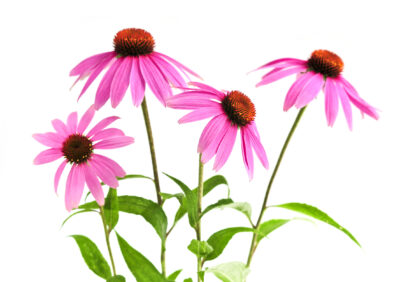
Can you take herbal supplements to arm your immune system? You probably know that zinc, vitamin D and vitamin C are gotta-have-its. How about herbal

While attending San Diego State College in the early seventies, my work-study job was in the vivarium, a room for keeping and raising animals for